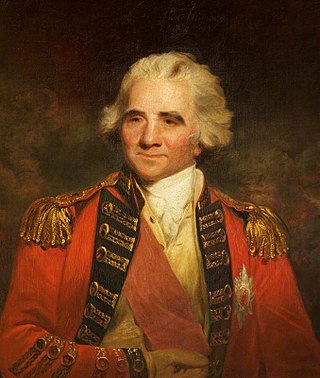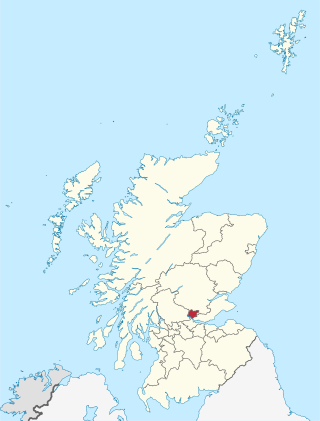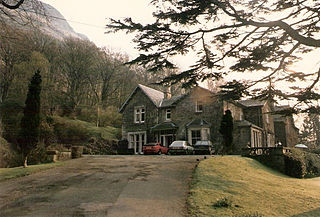
Lieutenant General Sir Ralph Abercromby was a Scottish soldier and politician. He rose to the rank of lieutenant-general in the British Army, was appointed Governor of Trinidad, served as Commander-in-Chief, Ireland, and was noted for his services during the French Revolutionary Wars, ultimately in the Egyptian campaign. His strategies are ranked amongst the most daring and brilliant exploits of the British army.

Clackmannanshire, or the County of Clackmannan, is a historic county, council area, registration county and lieutenancy area in Scotland, bordering the council areas of Stirling, Fife, and Perth and Kinross. In terms of historic counties it borders Perthshire, Stirlingshire and Fife.

Earl of Rosslyn is a title in the Peerage of the United Kingdom. It was created in 1801 for Alexander Wedderburn, 1st Baron Loughborough, Lord Chancellor from 1793 to 1801, with special remainder to his nephew Sir James St Clair-Erskine, as Wedderburn had no surviving issue of his own. Wedderburn had already been created Baron Loughborough, of Loughborough in the County of Leicester, in the Peerage of Great Britain in 1780, with normal remainder to the heirs male of his body, and Baron Loughborough, of Loughborough in the County of Surrey, in the Peerage of Great Britain in 1795, with the same remainder as the earldom. The 1780 barony became extinct upon his death, but the 1795 barony and the earldom passed, by the special remainder, to his nephew, who thus became the second Earl of Rosslyn. The second Earl was a Lieutenant-General in the Army and also held political office as Lord Privy Seal and Lord President of the Council.

Baron Abercromby, of Aboukir and Tullibody, was a title in the peerage of the United Kingdom. It was created on 28 May 1801 for Mary, Lady Abercromby, in honour of her husband, the noted military commander Lieutenant-General Sir Ralph Abercromby, who won the Battle of Aboukir in 1801 and later died from wounds at the Battle of Alexandria. The latter was the grandson of Alexander Abercromby, member of the Scottish Parliament for Clackmannanshire from 1703 to 1707, younger son of Sir Alexander Abercromby, 1st Baronet, of Birkenbog.
Captain Sir Alexander Holburn, 3rd Baronet was a Scottish sea captain in the Royal Navy. He was the second son of the advocate Sir James Holburn, 2nd Baronet by his second wife Jean, the daughter of Alexander Spital of Leuchat. Alexander succeeded to the baronetcy on the death of his father in 1758 when he was killed at sea in 1756.
Major General Sir James Holborne of Menstrie was a Scottish soldier during the years of the English Civil War. He eventually reached the rank of Major General and fought with the Parliamentarians during the English Civil War, fighting at Newbury and Taunton. Although he initially fought on the side of the English Parliament, he later became a senior officer in the Scottish Army, fighting against Cromwell. He lived at Menstrie Castle, in Menstrie, Clackmannanshire, central Scotland, which he had purchased in 1649.

William Alexander, 1st Earl of Stirling PC was a Scottish courtier and poet who was involved in the Scottish colonisation of Charles Fort, later Port-Royal, Nova Scotia in 1629 and Long Island, New York. His literary works include Aurora (1604), The Monarchick Tragedies (1604) and Doomes-Day.

Earl of Stirling was a title in the Peerage of Scotland. It was created on 14 June 1633 for William Alexander, 1st Viscount of Stirling. He had already been created a Baronet, of Menstrie, Clackmannanshire in the Baronetage of Nova Scotia on 12 July 1625, then Lord Alexander of Tullibody and Viscount of Stirling on 4 September 1630, then Earl of Dovan in 1639. He was made Viscount of Canada at the same time that he was granted the earldom of Stirling. The other peerage titles were also in the Peerage of Scotland. The titles became dormant upon the death of the fifth Earl in 1739.

Menstrie is a village in the county of Clackmannanshire in Scotland. It is about five miles east-northeast of Stirling and is one of a string of towns that, because of their location at the foothill base of the Ochil Hills, are collectively referred to as the Hillfoots Villages or simply The Hillfoots.

Blairlogie is a village in the Stirling council area of Scotland, situated at the base of the great southern rock-face of Dumyat between Stirling and Menstrie.

Tullibody is a town set in the Central Lowlands of Scotland. It lies north of the River Forth near to the foot of the Ochil Hills within the Forth Valley. The town is 1.8 miles (2.9 km) south-west of Alva, 1.8 miles (2.9 km) north-west of Alloa and 4.0 miles (6.4 km) east-northeast of Stirling. The town is part of the Clackmannanshire council area.

The Holburn Baronetcy, of Menstrie in the County of Clackmannan, was a title in the Baronetage of Nova Scotia. It was created on 21 June 1706 for James Holburn who was later titled, Sir James Holburn, 1st Baronet. He was the son of Major General Sir James Holborne of Menstrie. The third Baronet was a captain in the Royal Navy. The fifth Baronet was founder of the Holburne Museum of Art, Bath, Somerset. On his death in 1874 the baronetcy became either extinct or dormant.

Moultrie Rowe Kelsall was a Scottish film and television character actor, who began his career in the industry as a radio director and television producer. He also contributed towards architectural conservation.
Brucefield is an 18th-century country house in Clackmannanshire, Scotland. It is located 4 kilometres (2.5 mi) east of Clackmannan. The house was largely built in 1724 by Alexander Bruce, younger of Kennet. It was restored in the early 20th century, and is now protected as a Category A listed building.

Argyll's Lodging is a 17th-century town-house in the Renaissance style, situated below Stirling Castle in Stirling, Scotland. It was a residence of the Earl of Stirling and later the Earls of Argyll. The Royal Commission regards it as “the most important surviving town-house of its period in Scotland”. At the end of the 20th century it became a museum.

The Alexanders of Menstrie, also known as the House of Alexander, are a sept of Clan MacAlister of Scotland. The family is said to descend from Somerled, Lord of the Isles. The seat of the clan was at Menstrie Castle in Menstrie, Clackmannanshire. Descendants of the Alexanders of Menstrie have become prominent in Ireland, England and the United States.
Before the Act of Union 1707, the barons of the shire of Clackmannan elected commissioners to represent them in the unicameral Parliament of Scotland and in the Convention of Estates. After 1708, Clackmannanshire and Kinross-shire alternated in returning one member to the House of Commons of Great Britain and later to the House of Commons of the United Kingdom.
Alexander Abercromby of Glassaugh, Fordyce, Banffshire was a Scottish Army officer and politician who sat in the Parliament of Scotland from 1706 to 1707 and as a Whig in the British House of Commons from 1707 to 1727.



















